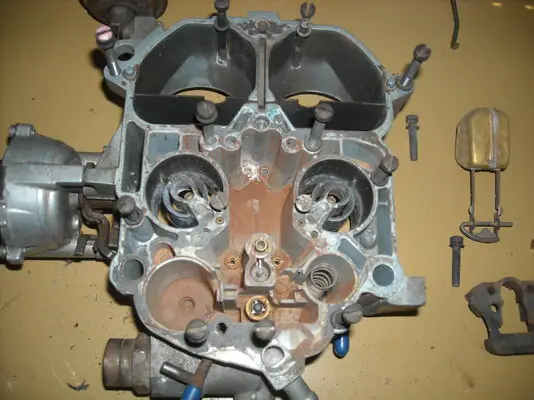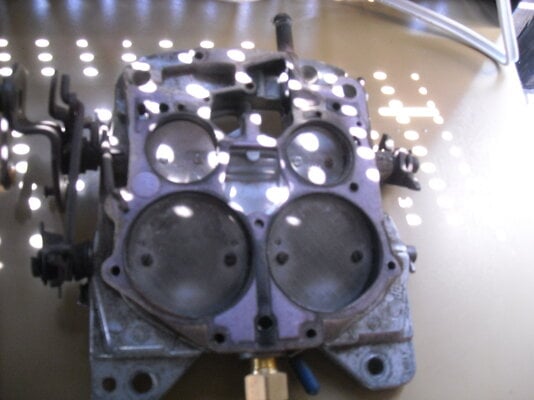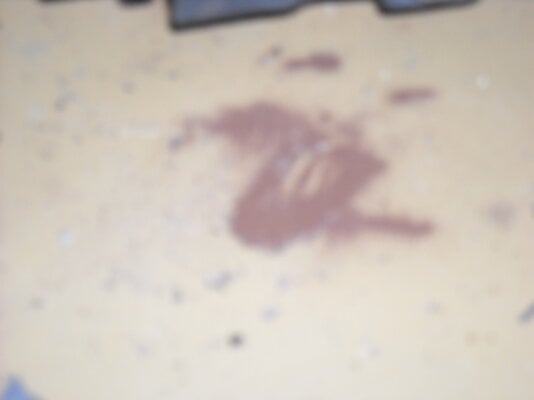I have drilled a lot of carbs on mostly stock engines and used what we called jewelers drills. Really small. I also have read that a tapered ream is better than a drill. Might be cutting hairs. I also would be specific to the area that was lean. Idle, pump, power, main and secondary circuits. This takes you to know the carb and what and where each individual circuit is. Of course, take all other factors out such as vacuum leaks, ignition and mechanical issues. I still have the drill bits and reams🙂
The $20 mystery Q-Jet (back to looking at it again)
- Thread starter pagrunt
- Start date
You are using an out of date browser. It may not display this or other websites correctly.
You should upgrade or use an alternative browser.
You should upgrade or use an alternative browser.
- Status
- Not open for further replies.
I have drilled a lot of carbs on mostly stock engines and used what we called jewelers drills. Really small. I also have read that a tapered ream is better than a drill. Might be cutting hairs. I also would be specific to the area that was lean. Idle, pump, power, main and secondary circuits. This takes you to know the carb and what and where each individual circuit is. Of course, take all other factors out such as vacuum leaks, ignition and mechanical issues. I still have the drill bits and reams🙂
Taper reamer is a nice idea but how would you set the depth. We use to use tape to set the depth for taper reamers but tape would be hard to use to open the idle port
Hi Donovan. I didn't know your name but we've posted back and forth before. I know very few first names on here unless it's in their avatar or something. I'm guilty of not including that too- I'll fix that. Yes, I have Cliff's book as well as Doug's and I have found that most Q-jet problems are solved with a good cleaning and checking it against specs. It is only when I get an orphan carb or build something GM never intended and need a one-off that I begin modifying. For example if the carb acts too small then it probably needs bigger jets since they affect the air/fuel ratio all across the rpm range. But if you get an off-idle stumble then you would try a different metering rod since that only affects off-idle to mid-rpm. WOT problems are where the secondary rods need attention. Over the years I have found that knowing what NOT to do is the most important thing. There are way too many car mag articles advising dumb procedures that get guys in trouble. Pagrunt did the right thing. He took an unknown carb and showed us what he had then asked for advice. You can't help wanting to help him out because you know he will appreciate it.
Hi Donovan. I didn't know your name but we've posted back and forth before. I know very few first names on here unless it's in their avatar or something. I'm guilty of not including that too- I'll fix that. Yes, I have Cliff's book as well as Doug's and I have found that most Q-jet problems are solved with a good cleaning and checking it against specs. It is only when I get an orphan carb or build something GM never intended and need a one-off that I begin modifying. For example if the carb acts too small then it probably needs bigger jets since they affect the air/fuel ratio all across the rpm range. But if you get an off-idle stumble then you would try a different metering rod since that only affects off-idle to mid-rpm. WOT problems are where the secondary rods need attention. Over the years I have found that knowing what NOT to do is the most important thing. There are way too many car mag articles advising dumb procedures that get guys in trouble. Pagrunt did the right thing. He took an unknown carb and showed us what he had then asked for advice. You can't help wanting to help him out because you know he will appreciate it.
No worries sir, I know we’ve talked on here the odd time before, but haven’t really gotten to “know” one another so to speak. Pleasure to make your formal acquaintance!
Trying to get my QJ to work on my engine was something that definitely fell into the “GM never intended” category, so that’s why the modifications I made ended up being as extensive as they were. Cliff’s recommendations and specs were spot on the money tho, that man definitely knows his way around those carbs.
Hopefully Pagrunt will find motivation and confidence in tackling the rebuild on his from positive experiences like mine, armed with the RIGHT info, it’s not only possible, but fairly easy to accomplish.
D.
And when I open it up I'll be posting more pics with questions. I really do appreciate the help from everyone on this.There are way too many car mag articles advising dumb procedures that get guys in trouble. Pagrunt did the right thing. He took an unknown carb and showed us what he had then asked for advice. You can't help wanting to help him out because you know he will appreciate it.
Over a year since posting I finally open it up today. Found out it's a Frankincarb. The base is dated '79, the body just has a 5 in the date circle so I'm going to say it's a '85 since it has an electric choke. Can't find any date codes on the top. Who ever rebult it last time glued the to gasket on, forgot to install the lower choke rod lever. Was never ran with a filter cause there was a ton of rust dust in it. It ran but had to run like 💩. Cleaned up the jets & they're marked 75. Can't tell what the metering rods are cause I can't understand the stampings on them. Outside of the rust dust It looks good inside, throttle shafts look & feel just right. If the jets are a good to go size, find the missing choke rod lever, get a new electric choke element, I should be able to pull off a basic rebuild & have it ready to go (after doing the proper research & reading.) That last pic is of the rust dust I dumped out of it.
Attachments
Now here are the p/n's for the three main sections:
Throttle body/base 17060558
Air horn/top 17073362
Main body 17077768(?) (casting hard to read)
As noted the base has a date of '79 on it, believing the body is dated '85, top us unknown but later production.
Figured if I find out what these are supposed to be on it might bring more info on what this carb was originally on.
Throttle body/base 17060558
Air horn/top 17073362
Main body 17077768(?) (casting hard to read)
As noted the base has a date of '79 on it, believing the body is dated '85, top us unknown but later production.
Figured if I find out what these are supposed to be on it might bring more info on what this carb was originally on.
#75 jets are pretty rich. Only time I have seen them is on a Pontiac 455. The rods have some tiny numbers stamped sideways. They refer to the fat end of the rod taper in thousandths of an inch. All tips are .026" if my brain is on straight tonight. This site has the best parts numbers for researching. http://www.newagemetal.com/
Last edited:
#75 jets are pretty rich. Only time I have seen them is on a Pontiac 455. The rods have some tiny numbers stamped sideways. They refer to the fat end of the rod taper in thousandths of an inch. All tips are .026" if my brain is on straight tonight. This site has the best parts numbers for researching. http://www.newagemetal.com/
Can't get the Qjet pages to open on that site. But I came across something on a Vette site using the the air horns' number & it claimed to be a '84-'86 3/4-1ton 454 carb.
Go to the Chevy section. Too bad it stops at 1980 because after that they used the CCC carbs which no one cares about.
- Status
- Not open for further replies.
Similar threads
- Replies
- 72
- Views
- 4K
- Replies
- 2
- Views
- 215
- Replies
- 17
- Views
- 571
GBodyForum is a participant in the Amazon Services LLC Associates Program, an affiliate advertising program designed to provide a means for sites to earn advertising fees by advertising and linking to amazon.com. Amazon, the Amazon logo, AmazonSupply, and the AmazonSupply logo are trademarks of Amazon.com, Inc. or its affiliates.





